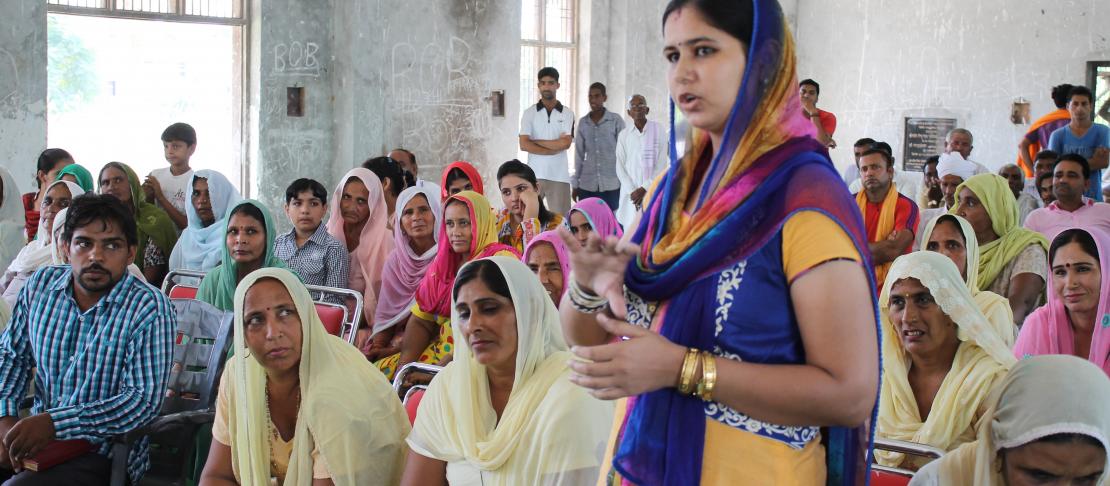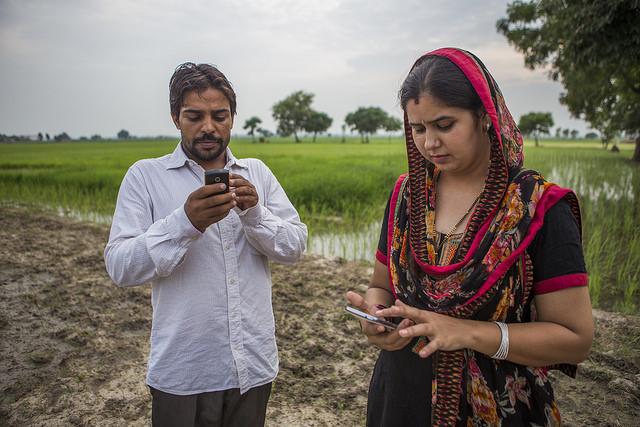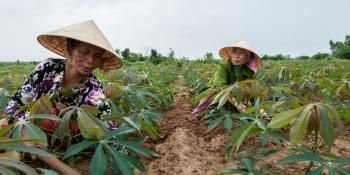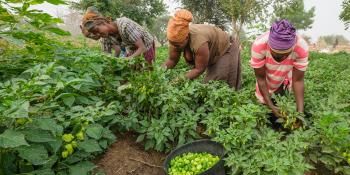For women farmers in Haryana, change starts with information

For climate information services to work they must target the entire family and not just male farmers. But how can we overcome existing barriers that prevent women from meaningfully engaging in agriculture?
“I have the right to know, to be aware of what is happening,” says 23-year-old farmer Ruby Mela.
If you want to know more about research on closing the gender gap in farming under climate change:
- read our special blog series on Closing the gender gap
- watch the presentations and the panel discussion from the Closing the gender gap event
- follow the #AgGenderGap event hashtag on twitter
Studies show that when it comes to accessing climate information and agro-advisory services, women farmers tend to be left out because of institutionalised socio-cultural barriers, low literacy levels, hectic daily schedules, and lack of agency in decision-making.
Not Ruby.
We are chatting in her house, which is set amidst wheat and maize fields. Her family includes her husband, their 14-month-old son and her parents-in-law. It is a hot afternoon in Anjanthali village, Haryana in north India and we welcome the respite to cool off indoors. But the heat should not belie the impending rain, her mother-in-law tells us with a smile.
Discussions about the weather are not smalltalk here. We want to learn more about how they are adapting to increasingly unpredictable weather patterns while managing their farms. For agriculture communities in the fertile Indo-Gangetic Plains, climate change and climate variability place profound challenges on their way of life.
Ruby and her husband Vinod are advocates for climate-smart agriculture under the Climate-Smart Village model. The model recommends a portfolio of practices and technologies best suited to local conditions. They are optimistic that zero-tillage, precision nutrient application, land laser levelling, and cultivating on raised-beds can increase their yields and incomes and save scarce resources like groundwater, which is depleting at an astonishing rate in these parts.
Read about Climate-Smart Villages
M(obile) Solutions for climate smart agriculture
As part of their climate-smart approach to farming, the couple are subscribed to M(obile) Solution. It is an ICT project, supported by the International Maize and Wheat Improvement Center (CIMMYT) and the CGIAR Research Program on Climate Change, Agriculture and Food Security (CCAFS), and working with local partners to provide climate information and agro advisories to farmers to increase knowledge and uptake of climate-smart agriculture and reduce their climate vulnerability. It offers an alternative model of information dissemination that incorporates farmers’ feedback by creating an information loop that not only pushes information, as traditional climate information services do, but also pulls back information from farmers.
Read: Project tests new ways to send information to farmers' phones

Ruby and her husband vinod have subscribed to (m)obile Solutions: Photo: Dharini Parthasarathy
Overcoming resistance
The project has taken special efforts to ensure that it is inclusive. Women farmers in rural Haryana typically rely on male members of the household to get information. Even the mere attempt to include women farmers in the project was met with resistance. But through focus group discussions and by involving local women leaders, women finally signed up. During some of the frank discussions, some people questioned why women needed to receive information if they are not taking any important decisions. What was the point?
Ruby explained why. As a busy mother, she is not farming everyday but having grown up in an agriculture community, she realises how information can empower farmers to do the right thing even under uncertain situations.
I never realised how much detail goes into farming. I feel it is important for women to have access to this information, to be able to participate in decision-making and family discussions on how we can improve our lives. Even if this happens just inside the household, it is a big step.”
What the data says
At the recent CCAFS-hosted event on Closing the Gender Gap, initial analysis of the data collected from the pilot study of the project carried out in Bihar and Haryana was presented.
Nearly 1,100 farmers received about 325 messages over a period of 9 months between 2013 and 2014. Feedback was randomly sought from 510 farmers, nearly 16 percent of who were women. The study, among other objectives, will see if female farmers receiving the information are receptive to the messages and ultimately to gauge if there is any behavioural change from accessing this information.
Surabhi Mittal speaks about the project at the "Close the Gender Gap" event
Many women farmers, particularly in the study villages in Karnal, are not directly engaged in agriculture but interestingly the average time they spent listening to the full voice message was the same as that of male farmers. This is a good indicator of their interest in the information provided, although it is yet to be seen if this translates into greater participation and decision-making in agriculture.
On the feedback form received from female farmers, it is clear that many appreciate the awareness it has created on climate-smart agriculture practices and the issue of climate change. Several of them noted they often shared the information with other women who were not part of the project.
It is imperative that extension services should target the entire family and not just male farmers. To reach women, it is important to understand how information services can overcome existing barriers and offer opportunities for women to meaningfully engage in all aspects of agriculture work.
We know afterall that gender equality starts within the household long before the effects of it are seen in the community.
Further reading:
The Hindu: Everyone has weather information on their fingertips in this village
This blog was drafted by Dharini Parthasarathy, CCAFS Communications Specialist, South Asia with inputs from Surabhi Mittal, Senior Researcher in CIMMYT.



